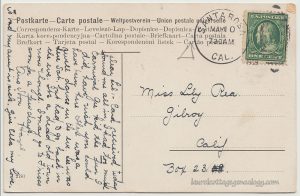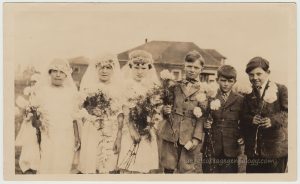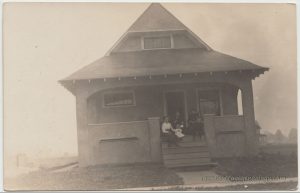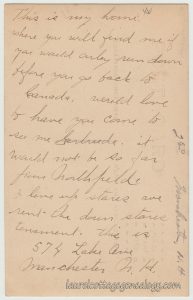

Divided back postcard. Postmarked May 10th, (year missing) from Santa Rosa, California. Printed in Germany. Publisher unknown. Number or series: 2781. Circa 1907 – 1914.
Price: $5.00
Addressed to: “Miss Lily Rea. Gilroy Calif. Box 23.”
With this postcard (see if the cottage doesn’t remind you of the house in the prior post) we’re getting back, momentarily, to the Lily Rea Collection (more to come later). This is a card from Lily’s good friend, Hazel, who writes:
“Dear Lil: – Card recieved today found me all in. I had too much carnival. Gee kid the fun I did have wish you could have been here. There was a swell dance in the eve. Lee was here Sat. but had to go back in the eve. Its a dead old town now though. I may go to F’risco soon for a few days. Ans. soon Hazel To bad my aunt is sick. Give Ella my love.”
Initials TM?
This could be an artist-signed card, per the marks in the lower left corner, as in the initials TM. (They don’t really look like they fit for markings in the grass.)

Only the postcard artist knows for sure?
It was over a hundred years ago that the artist rendered the charming scene for this card, and we suspect that if this painting had been done today, it would not include the sort of bulky topping on the roof with the jutting horn-like things….It makes one realize that over the years details can get lost and form become homogenized…..and then makes one appreciate when historical references come shimmering in, sometimes from the most unlikely places. And so, was it from memory that the artist worked, or a “present-day” cottage he painted from, or maybe it was his artistic expression of something like the carved animal heads in the illustration below (see Low German house). Here we’re at one of those points where one sees oneself writing a book (if one had the time, put everything on hold and take five years) on the subject of rooftop decorations, symbols, significance, etc. throughout the world from the earliest ones found to modern day. (No small task, but it would be beautiful!)

Lastly, while googling “thatched roofs decorations” we were happy to discover that thatching is still alive and well today. And check out these modern-day examples of thatch ornaments from some of the master thatchers in the UK, Brian and Tom Mizon.
Sources: “Straw Finials / Straw Animals / Straw Ornaments.” http://brianmizonthatching.co.uk/ (accessed October 8, 2018).
Low German house. n.d. https://en.wikipedia.org/wiki/Low_German_house (accessed October 20, 2018).













